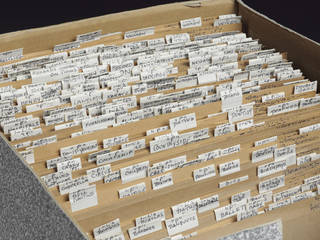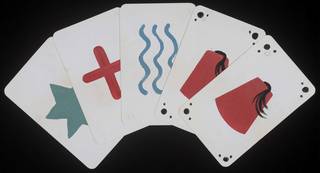The Tommy Cooper Collection comprises over 116 boxes of archive material and 24 props and posters to chart the career of the outwardly shambolic magician and comedian known for his trademark fez, flustered face, bungling stage persona and razor-sharp comedy.

From his early career in the army to the height of his television stardom and status as national treasure, the collection also sheds light on Cooper’s scrupulously organised working methods, the business side of his vocation and the extent of his writing. Cooper only used a small percentage of all the material he amassed as part of his ‘Gag File’, a system for storing his jokes, ordered alphabetically with the meticulousness of an archivist. The collection also includes Cooper’s writings, some jotted down on backs of posters and shirt packaging cardboard, as well as documents relating to the inner workings of his career, such as contracts from 1946 to his death in 1984 – including those he could not fulfil following his unexpected passing during a live performance.

It is wonderful that the V&A has acquired the Tommy Cooper Collection and that the public will get to see some of his material on display later this year. I hope it brings as much enjoyment and a big smile on everyone’s face as he did when he was alive. My dad would be very proud knowing he was now represented in the National Collection of Theatre and Performance, sitting alongside the likes of Ronnie Barker’s archive and costumes worn by Morecambe and Wise and Stan Laurel.

Other highlights from the collection include stage props, such as Cooper’s infamous ‘Head Twister’ illusion; details of early auditions at the BBC and engagements; a folio notebook full of his gags; personal correspondence; posters; theatre programmes and merchandise charting his career spanning almost four decades. A selection of these objects will go on public display for the very first time in the our Theatre and Performance Galleries. The archive will be available for research, once catalogued, and digital records will also be available on Search the Collections.

The Tommy Cooper Collection offers a fascinating insight into one the best-loved entertainers of the 20th century and reveals much about his practice, process and legacy. Although it doesn’t contain one of his iconic fezzes, the rich collection contains thousands of hand-written gags as well as unique examples of his comedy props.

Tommy Cooper was a fanatical magician and consummate showman who discovered the comedy in failed magic tricks as a teenager in the canteen of the firm where he was apprenticed as a shipbuilder in Hythe, Hampshire. After wartime service with the Horse Guards and valuable experience performing with the Navy, Army and Air Force Institutes and the Combined Services Entertainment, he met the jazz musician Miff Ferrie whose job as Entertainments Director at London’s Windermere Club secured him his first engagement there in November 1947. Previously that year he had failed initial auditions at both the Windmill Theatre and with the BBC.
Tommy was truly a great and wondrous comedian. He possessed and was possessed by the comic spirit. He loved laughter and he loved to laugh. I’m sure he would have been very proud to see so many people enjoy his sense of humour.

Cooper went on to star in his own television shows, to perform for the Queen, Royal Family and the Royal Household at Windsor castle, to appear in three Royal Variety shows, and to become one of Britain’s most original, highest-paid, most impersonated and best-loved entertainers of the 20th century.


